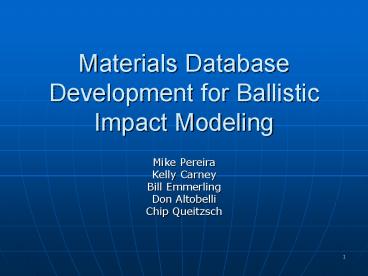Materials Database Development for Ballistic Impact Modeling - PowerPoint PPT Presentation
1 / 27
Title:
Materials Database Development for Ballistic Impact Modeling
Description:
Lack of high quality set of data to develop and verify impact models ... Material Model Creation. LS-DYNA material model(s) will be created for each tested material ... – PowerPoint PPT presentation
Number of Views:266
Avg rating:3.0/5.0
Title: Materials Database Development for Ballistic Impact Modeling
1
Materials Database Development for Ballistic
Impact Modeling
- Mike Pereira
- Kelly Carney
- Bill Emmerling
- Don Altobelli
- Chip Queitzsch
2
Problem
- Lack of consistency in material modeling
practices - Lack of high quality set of data to develop and
verify impact models - Data typically assembled from a number of
different sources - Lack of quantitative measurements to evaluate
model accuracy - Limited pedigree
3
Objective
- Develop a set of data to help improve and
validate computational impact models - Material property data
- Ballistic impact test results
- Model inputs and results
- Initially two metallic materials will be
considered. More will be added as the database
evolves.
4
Initial Materials
- Ti-6Al-4V
- 0.080 in
- 0.140 in
- 0.25 in
- Al 2024-T3/T351
- 0.125 in (T3)
- 0.25 in (T351)
- 0.50 in (T351)
5
Database Contents
- Material Property Data
- Shear, compression and tension
- Different strain rates
- Different temperatures
- Ballistic Impact Test Data
- Flat plate tests
- Subcomponent tests
- Damage Characterization
6
Material Property Measurements
- Tension, shear, and compression tests will be
done at various strain rates ranging from 10-4 to
5x103 s-1. Tests at various elevated
temperatures will be done at one of the strain
rates. - Uniaxial tension tests, uniaxial compression
tests, and torsion tests at strain rates from
10-4 to 2 s-1 will be done using a hydraulic
Instron machine. Tests at strain rates from 300
to 5000 s-1 will be done using the tension,
compression, and torsion split Hopkinson bar
techniques.
7
Room temperature testsAl 2024-T351
8
Elevated temperature tests Al 2024-T351strain
rate of 1 s-1
9
Room temperature tests - Ti-6-4
10
Elevated temperature testsTi-6-4strain rate 1
s-1
11
Ballistic Impact Tests
- Flat panel tests
- Subcomponent tests
12
Flat Panel Tests
- Design projectile so that ballistic impact
velocity is between 600-900 ft/sec - 15 square panels rigidly clamped on four sides
with a 10 square aperture - Cylindrical projectile with a large radius nose,
normal impact
13
Impact Gun
14
Preliminary Test Fixture
15
Test Fixture
16
Projectiles
17
Subcomponent specimen
Half Ring Specimen
Projectile
18
Large gas gun
19
Instrumentation
- Point strain on backside (strain gages)
- Impact velocity
- Exit velocity
- Projectile orientation
- Full field displacement/strain (stereo photo
instrumentation)
20
Point strain measurement
Rosette
Unidirectional gage
21
High speed video
22
Projectile Orientation
Z
X
e2
e3
e1
Y
23
Full-field displacement and strain
24
Material Model Creation
- LS-DYNA material model(s) will be created for
each tested material - As much as possible, current material models will
be utilized - New constitutive models will only be created if
needed
25
Material Model Selection
- Initially, models which directly use the stress
strain curves will be selected - Specifically, Mat 24, Piecewise Linear
Plasticity, Mat 81, Plasticity with Damage, and
Mat 123 Modified Piecewise Linear Plasticity will
be examined - Full stress strain behavior including strain rate
effects will be included
26
Practice and Verification
- As much as possible, the material model
parameters and curves will be generated from
mechanical property tests, both static and
dynamic - All of the ballistic tests will be simulated
using the new material models and appropriate
meshes - The ballistic tests will be used to verify the
accuracy and robustness of the material models
27
Internet Database
- All information related to the tests and models,
including raw data, high speed video, test
parameters, DYNA input decks will be contained in
the database - Cooperating users will have on-line access to all
data and models - Users will have the opportunity to submit their
own models and data, subject to certain quality
criteria - Objective is to continue developing the database
with additional materials, including composite
materials.































